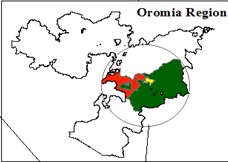Participatory demonstration and evaluation of bread wheat technologies: The experience of FRG/FREG approach in Bale and West Arsi zones of Oromia national regional state, Ethiopia
Keywords:
Bread wheat, Demonstration, FRGs/FREGs, Farmers’ preferences, Selection criteriaAbstract
The paper presents the result of participatory demonstration, evaluation and validation of recently released 4 improved bread wheat varieties (Danda’a, Huluka, Hidase and Shorima) with joint participation of farmers, agricultural experts, development agents, researchers and other stakeholders in Sinana and Agarfa districts of Bale and Dodola district of West Arsi Zones of Oromia National Regional State, Ethiopia in the year 2012/13 through the support of East African Agricultural Productivity Project (EAAPP). Generating, demonstrating, evaluating, validating, popularizing and disseminating improved bread wheat technologies to smallholder farmers are vital in facilitating adoption of these technologies. The objectives were to demonstrate, evaluate and validate the productivity of improved bread wheat technologies under farmers’ condition in the target areas, to improve farmers’, development agents’ and agricultural experts’ capacity (KSA) through training on wheat production techniques and management practices/packages, to establish FRGs/FREGs, to enhance linkage among the relevant stakeholders and to recommend the best-bet improved bread wheat varieties for further pre-scaling up activity. Three wheat growing potential kebeles were selected from each participant districts and a total of nine kebeles were selected for the study. One FRG/FREG having 20 members with the composition of men, women and youth farmers was established in each kebele. A total of 180 farmers were participated in the activity. Three trial farmers from FRG/FREG members were selected at each kebele (27 hosting model farmers in three districts) with the help of group members and DAs. Farmers were considered as replications. A total of 225 individuals (87.56% male and 12.44% female) from the three districts (180 farmers, 15 agricultural experts, 27 DAs & 3 supervisors) were participated on both theoretical (in-room) and practical (on-spot) training on wheat production and management packages. A total of 202.5 kg seeds of the five demonstrated varieties (40.5 kg of each variety), 67.5 kg UREA and 135 kg DAP were distributed to 27 trial farmers for demonstration purpose. One liter Pallas 45 OD herbicide was used for demonstration purpose on 1.814 ha (18144 m2) land of 27 trial farmers. To show the performance of demonstrated varieties, mini field day was jointly organized in collaboration with other stakeholders at each district and about 300 participants were participated on this event including FRGs/FREGs members and follower farmers in the area. A total of 688 participants were participated on evaluation of the varieties. Uniformity in germination, good tillering capacity (> 10 is preferable), disease resistant (especially yellow and stem rusts), good spike length, number of seeds per spike (> 60 is preferable), good grain yield (> 6 tons/ha), no irregular maturity because of late tillers, and not very late or early, ease for mechanization (medium size), good for consumption/bread making and marketable were the best criteria identified by the evaluators for selecting the best-bet variety/ies. Madda Walabu and Danda’a were selected in the first place, where as Hidase is preferred for its good yield with the availability of fungicides. In this activity, farmers were identified as reliable partners in the participatory plant breeding program. This approach will not only be resource saving in terms of preferred variety promotion/dissemination, but also time saving and fast adoption.References
Agarfa District Agriculture Development Office, 2014. Annual Report (Unpublished).
Bale Zone Agriculture Development Office, 2014. Annual Report (Unpublished).
Bekele D., 2011. Analysis of rural women farmers’ drudgery and their role in agricultural production: The case of Sinana districts, Bale zone, Oromiya national regional state, Ethiopia. M. Sc. Thesis. Haramaya University, Ethiopia.
Bureau of Finance and Economic Development, 2009. Profile of Oromia National Regional State.
Central Statistical Agency (CSA), 2013. The Federal Democratic Republic of Ethiopia. Central Statistical Agency Agricultural Sample Survey 2011/2012 (2004 E.C.): Report on Area and Production of Major Crops (Private Peasant Holdings, Meher Season), Volume I. Addis Ababa, Ethiopia.
Crop Variety Registry Book, 2012. Addis Ababa, Ethiopia.
Dan Makosa, 2012. Integrating consumer preferences into breeding: A stepping stone to food security. Department of Agricultural Economics, Tokyo University of Agriculture, Japan. Presented on Wheat for Food Security in Africa. October 8-12, Addis Ababa, Ethiopia.
Dodola District Agriculture Development Office, 2014. Annual Report (Unpublished).
Food and Agricultural Organization of the United Nations (FAO), 2014. The State of Food and Agriculture. Innovation in Family Farming. Rome.
Sinana Agricultural Research Center (SARC), 2014. Information Bulletin, December.
Sinana District Agriculture Development Office, 2014. Annual Report (Unpublished).
Tolesa A., 2014. Adoption of improved agricultural practices and wheat production efficiency of smallholders in Arsi zone of Ethiopia. Ph. D. Dissertation. Haramaya University, Ethiopia.
West Arsi Zone Agriculture Development Office, 2014. Annual Report (Unpublished).

Published
How to Cite
Issue
Section
Copyright (c) 2020 Amare Biftu, Bekele Diriba, Tilahun Bayisa, Firehiwot Getachew

This work is licensed under a Creative Commons Attribution-NonCommercial-NoDerivatives 4.0 International License.



